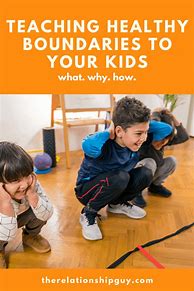Best Ways to Teach Children About Personal Safety and Boundaries
In today’s world, it’s more crucial than ever to equip our children with the knowledge and skills they need to stay safe. Teaching children about personal safety and boundaries is an essential part of raising them to be confident and empowered individuals. This comprehensive guide will provide parents, educators, and caregivers with actionable steps to instill these vital lessons in young minds.
Start Early: Laying the Foundation for Safety
The earlier you start, the better. It’s never too early to begin instilling safety awareness in your children. Begin by teaching them their full name, address, and phone number. This information can be essential if they ever get lost. Furthermore, teach them about the importance of trusting their gut feelings. If something feels wrong, it probably is. Encourage them to speak up if they are uncomfortable or scared, and let them know that you will always listen to them without judgment.
Building a Foundation of Trust
The foundation of a child’s understanding of personal safety and boundaries starts with trust. Building a strong and open relationship with your child is crucial, enabling them to feel comfortable confiding in you.
- Active Listening: Listen attentively when your child talks to you. Validate their feelings and make them feel heard.
- Open Communication: Encourage your child to ask questions and voice concerns, no matter how small they may seem.
- Consistent Messages: Be consistent in your messages about safety and boundaries. Avoid sending mixed signals, and be clear in your expectations.
Teaching Body Safety: "My Body Belongs To Me"
Body safety is a fundamental aspect of personal safety. It teaches children to recognize and respect their own bodies, and to understand that they have the right to say no to any unwanted touch.
Using Simple and Age-Appropriate Language
- “Good Touch” and “Bad Touch”: Explain the difference between appropriate and inappropriate touch in a simple way. Good touches are loving and make you feel safe, while bad touches make you feel uncomfortable or hurt.
- “My Body Belongs To Me”: Emphasize that children have the right to say no to any touch that makes them feel uncomfortable, even if it’s from someone they know and love.
Empowering Children to Say No
- Role-Playing: Practice different scenarios with your child, such as how to say “no” if someone tries to touch them inappropriately.
- “My Body is Private”: Teach children that they can choose who touches them and where. Explain that their private parts should only be touched by them or by a trusted adult for medical reasons.
Understanding Good Touch and Bad Touch: Simple Explanations for Young Minds
It’s important to explain the concept of good and bad touches in a way that children can easily understand. Keep it simple and direct.
Good Touches:
- Hugs and Kisses: Explain that good touches are often loving and make you feel safe. They’re usually from people you love and trust.
- Helping Hands: Sometimes, good touches can be from trusted adults who are helping you. For example, a doctor giving you a checkup.
Bad Touches:
- Uncomfortable Touches: Explain that bad touches make you feel uncomfortable or hurt. They can be from someone you know or someone you don’t know.
- Secret Touches: Tell children that bad touches are often done in secret. If someone tells you not to tell anyone about a touch, it’s probably a bad touch.
Building Trust and Open Communication: Creating a Safe Space to Talk
Open communication is vital for children to feel comfortable discussing safety concerns. Encourage them to talk about any uncomfortable or scary situations. Make sure they know that you are always there to listen and support them.
Creating a Safe Space:
- Active Listening: When your child talks to you about something that makes them feel uncomfortable, listen attentively and without judgment.
- Validate Feelings: Let your child know that their feelings are valid. It’s okay to feel scared or uncomfortable, and you are there to help.
- No Shame: Make it clear that there is no shame in talking about safety concerns. It’s important to encourage open communication.
Recognizing Safe and Unsafe Situations: Empowering Children to Make Good Choices
Equip children with the knowledge and skills to recognize unsafe situations. This will empower them to make good choices that protect their safety.
Teaching Children to Trust Their Gut
- “If It Feels Wrong, It Probably Is”: Teach children to trust their instincts. If something feels unsafe, encourage them to remove themselves from the situation or seek help.
- “No Means No”: Emphasize that children have the right to say “no” to anything that makes them uncomfortable, even if it’s from a trusted adult.
Recognizing Boundaries
- Personal Space: Help children understand the importance of personal space. They have the right to say no to being touched by someone who makes them feel uncomfortable, even if it’s someone they know.
- Respecting Others: Just as children have the right to say no, they should also respect the boundaries of others. Teach them to be mindful of personal space.
Setting Boundaries: Learning to Say No and Ask for Help
Learning to set boundaries is an essential life skill. Children should feel comfortable saying no to situations that make them uncomfortable and seeking help from trusted adults.
Teaching Children to Assert Themselves
- “It’s Okay to Say No”: Help children understand that it’s okay to say no to things that make them feel uncomfortable, even if it’s from a trusted adult.
- “You Can Ask for Help”: Emphasize that it’s okay to ask for help from trusted adults if they feel unsafe or uncomfortable.
Using Assertive Communication
- Eye Contact and Strong Voice: Encourage children to use eye contact and a strong voice when saying no.
- Repetition: If necessary, children can repeat their refusal to make it clear they mean it.
The Power of "No": Encouraging Children to Assert Themselves
Saying no is an act of self-defense. It’s essential to empower children to assert their boundaries and to communicate their needs effectively.
Building Confidence
- Positive Reinforcement: Praise children when they demonstrate assertiveness, even if it’s a small step.
- “I’m Sorry, But I Can’t”: Encourage children to use phrases like “I’m sorry, but I can’t” when they need to refuse something.
Recognizing Different Scenarios
- Peer Pressure: Explain that it’s okay to say no to their friends if something feels wrong or unsafe.
- Adults: Help children understand that they can say no to adults, even those they know.
Role-Playing Scenarios: Practicing Safety Responses
Role-playing is a fun and effective way to help children practice safety responses. Create realistic scenarios that might occur in their daily lives.
Creating Scenarios
- Getting Lost: Practice what to do if a child gets lost in a public place. Encourage them to stay in a safe place, find a trusted adult, and ask for help.
- Approached by a Stranger: Practice how to respond if a stranger tries to talk to them or touch them. Encourage them to say no, run away, and tell a trusted adult.
Providing Positive Feedback
- Praise Effort: Be sure to praise your child’s efforts, even if they make mistakes.
- Encourage Practice: Regularly practice safety responses so that they become second nature.
Teaching Stranger Safety: Recognizing Potential Threats
Teaching children about stranger safety is crucial to keeping them safe. Children need to understand that not all strangers are bad, but it’s important to be cautious.
Understanding the Difference Between Strangers and Trusted Adults
- “Good Strangers” and “Bad Strangers”: Explain that there are good strangers, such as police officers, firefighters, and other helpers, and bad strangers who might try to hurt them.
- Trusted Adults: Emphasize that they should only talk to or go with trusted adults that they know well.
Stranger Safety Tips
- “Never Go Anywhere with a Stranger”: Emphasize that they should never go anywhere with a stranger, even if the stranger says they know their parents or offers them candy or gifts.
- “Tell a Trusted Adult”: Teach children to tell a trusted adult if a stranger makes them feel uncomfortable or unsafe.
Empowering Children with Self-Defense Techniques: Building Confidence and Safety Skills
Teaching children basic self-defense techniques can empower them to protect themselves if they ever feel unsafe.
Simple Self-Defense Skills
- “Yelling Loudly”: Encourage children to yell loudly if they feel threatened. This can scare off an attacker.
- “Running Away”: Teach children to run away from a dangerous situation if possible.
- “Kicking or Punching”: If a child feels threatened, they can use simple self-defense techniques like kicking or punching.
Building Confidence
- “You Are Strong”: Help children understand that they are strong and capable of protecting themselves.
- “It’s Okay to Fight Back”: Explain that it’s okay to fight back if they feel threatened.
Conclusion
Teaching children about personal safety and boundaries is an ongoing process. It’s important to start early, be consistent, and create an open and trusting relationship with your child. By equipping children with the knowledge and skills they need to stay safe, you are empowering them to lead healthy and happy lives. Remember, the key is to create a safe and supportive environment where children feel comfortable talking about safety concerns and seeking help.
FAQs
Q: What are some age-appropriate ways to talk about safety with young children?
A: Keep it simple and use clear language they understand. Use stories, books, and games to make learning fun. Focus on building trust and encouraging open communication.
Q: How can I teach my child about body safety without scaring them?
A: Use positive and empowering language. Focus on teaching them that their bodies are their own, and they have the right to say no to unwanted touch. Avoid using scary or threatening language.
Q: How can I help my child learn to recognize safe and unsafe situations?
A: Role-play different scenarios. Use real-life examples to teach them about potential dangers. Emphasize the importance of trusting their gut feelings and seeking help from trusted adults.
Q: What if my child tells me about a bad touch?
A: Stay calm and listen attentively. Believe your child and reassure them that they did the right thing by telling you. Seek professional help from a therapist or counselor.
Q: What are some self-defense techniques that I can teach my child?
A: Teach simple techniques like yelling loudly, running away, and kicking or punching. Focus on building confidence and empowering them to protect themselves if they feel threatened.
Q: How can I create a safe and supportive environment for my child?
A: Listen attentively to your child. Validate their feelings. Encourage open communication. Make sure they know they can always come to you for help.
Remember: It’s important to stay informed and continue to learn about personal safety and boundaries. There are many resources available online and in your community. By taking an active role in teaching your child about these important topics, you are giving them the tools they need to stay safe and thrive.

